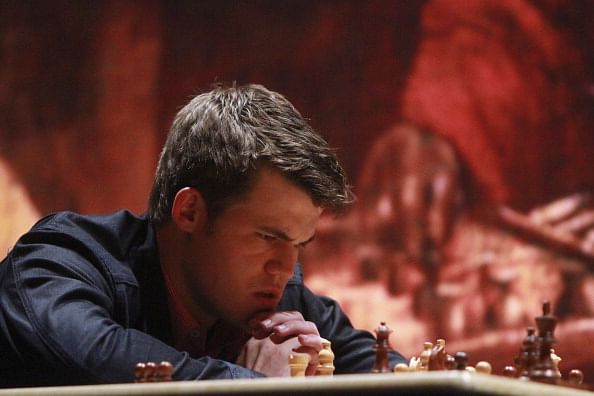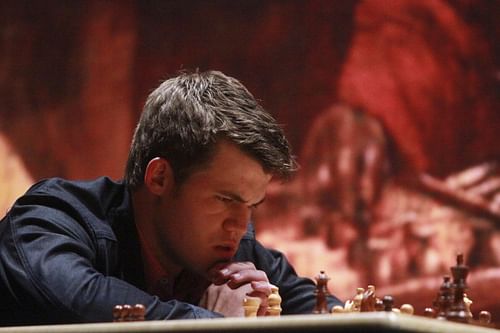
Magnus Carlsen en route to be likened to Gary Kasparov, says former coach Agdestein

Magnus Carlsen
How Magnus Carlsen Became the Youngest Chess Grandmaster
The Story and the Games by Simen Agdestein
Publisher: New In Chess, 2013
Expected to be available on Amazon by September 16 for $14.65. Currently on New in Chess for $19.95.
At the age of 13 years, 4 months and 26 days, Magnus Carlsen became the youngest chess Grandmaster in the world. The international press raved about the Norwegian prodigy. ‘The Washington Post’ even called him ‘the Mozart of chess’.
Ten years on, Magnus Carlsen is number one in the world rankings and a household name far beyond chess circles. ‘Time Magazine’ listed him as one of the 100 most influential people in the world in 2013.
The fairy-tale-like story of Magnus Carlsen’s rise is told by Simen Agdestein, who trained Magnus in the years leading up to his Grandmaster title, repeatedly pinching himself in amazement at his pupil’s lightning progress.
Agdestein explains the secrets of Magnus’ play in clear and instructive comments and tells about the Carlsen family life. The story of Magnus’ fabulous journey will fascinate parents and help gifted children to realize their full potential.
Simen Agdestein is a most remarkable double talent. Not only did he win the Norwegian national chess championship six times, but he also used to be a highly gifted football player. He played for Lyn FC in Oslo and represented the Norwegian national soccer team on eight occasions.
This book was previously published as “Wonderboy’. Here are some of the reviews:
Jan Timman, former World Chess Championship finalist:
“Compelling tale, exciting chess.”
Heinz Brunthaler, Rochade Europa Magazine:
“From beginners’ errors to better and better achievements, the reader learns how a real chess prodigy develops, temporary setbacks and disappointments included … One has to give great praise to the author for his honesty and empathy and for the unselfish way he tells the story.”
Herman Grooten, author of ‘Chess Strategy for Club Players’:
“A splendid book, accessible for a big audience.”
Taylor Kingston, ChessCafe:
“No doubt about it, the kid is good (..) Agdestein does a good job indicating how various moves and ideas show Carlsen’s growth as a player.”
Johan Hut, Gooi en Eemlander:
“A wonderful book for children, but also for adults.”
Minze bij de Weg, SchaakMagazine:
“It is quite special to see how this boy, when he is 10 years old, starts to advance with giant strides through the chess world. That is why playing through these games is such a valuable experience.”
Jules Welling, Schaaknieuws:
“I finished it in one go.”
Harald Fietz, Schach Magazine:
“Agdestein’s insider story is packed with detailed information about what makes the boy so successful.”
Max Pam, Het Parool:
“What Agdestein has written is clearly a labor of love.”
In the preface to the book, Agdestein writes:
“I assured myself after writing the first edition of this book that there would be no follow-up. No Wonderboy II or III from me. Magnus had be come a Grandmaster at an extremely early age and I had been given the chance to follow this extraordinary talent from when he started getting interested in chess at the age of 9 to when he was the youngest Grandmaster in the world four years later. It was an adventure and certainly a story to tell!
However, such enormous success also brings a lot of pressure. Magnus has been a prey for journalists since he was 13 and I didn’t want to add to this by pretending I was his personal biographer. I was worried already then about how all this attention would affect him. Magnus certainly was very mature for his age and chesswise he was of professor level even before he was a teenager. But still, he was just a child. In hind sight we can breathe a sigh of relief that things turned out as well as they did. Magnus became the number one in the world when he was 19 and is now way ahead of the next players in rating.”
On Kasparov and Carlsen
Agdestein writes: “There are actually a few things that we talked about when Magnus was just a little boy that we can still see in the way Magnus plays to day. Kasparov was really dominant at that time, but one day he would quit, and then how would the next number one play? Anatoly Karpov had his style, and it worked in his day – Kasparov had a completely different style. Kasparov was the first and the best in exploiting the power of the computer, but the others followed in his footsteps and soon their preparation became just as good as Kasparov’s.
“The way to get away from all this would simply be to vary your openings all the time. Kasparov’s opening repertoire was fairly limited (although I believe he knew absolutely every thing!). The next number one had to be totally unpredictable. And that is exactly what Magnus is now. He can play anything and you never know what to expect from him. While Kasparov is (or was) concerned about ‘eternal values’, Magnus is only interested in what works to beat that particular opponent on that particular day. I have the impression that Kasparov was close to analysing many of his lines until the very end, but this approach seems more like science.
“Magnus is a sportsman. By changing your openings all the time you force your opponent into unknown territory and you also keep the game much more interesting for yourself. How exciting it is to discover new ideas over the board!
“It would have been interesting to see Kasparov’s depth added to Magnus’ pragmatism, but the general answer to all this well-meaning ‘advice’ is that you can’t argue with success. Magnus has been extremely successful with his over-the-board fighting approach. Now he is the number one, and the one whose play everyone tries to imitate. In that respect, he’s very powerful.”
Agdestein writes in the preface, “When Magnus left school three years later, he was the number 3 in the world. He then started to train with Garry Kasparov and soon rose to the very top. It must have been tremendous working with the man who I believe is the greatest chess player in history ever (Magnus still has a way to go be fore he can compete with Kasparov in that respect). Magnus even got hold of Kasparov’s database with all his work from the last 20 years or so. According to Magnus that was pure gold!
“However, I don’t see that much of Kasparov in Magnus’ style today, I must say. Without claiming any honour or anything – I’m just one of many that have been around Magnus –, to me it seems that Magnus is now playing more or less exactly the way we already visualized when he was 10.”
Agdestein talks about the whole lot of hard work that has gone into nurturing Carlsen and, of course, the will to win the upcoming World Chess Championship in Chennai against Viswanathan Anand. We just cannot seem to wait – for the book and the championship.